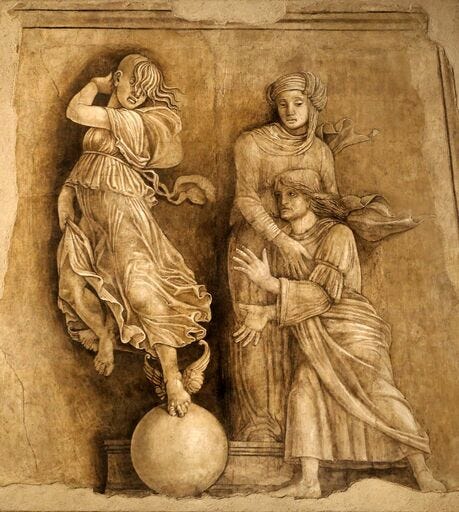It has become increasingly apparent I will be driving this conversation on power in a sui generis way; less through books, than in parts, a lot of them bodily and/or ‘localised.’1
This is a pondered decision: after all, consider the most notable representation of a body politic is the frontispiece to Hobbes’ Leviathan. An iconologic / poietic / postlogic approach to power may also allow me an opacity and subtlety that keeps what in my message must be grise, grise.
The technique I’ll be applying for this survey of power is thus, appropriately, an adaptation of grisaille, for the following three reasons:
Grisaille is liminoid, to the extent that Huberman calls it “the medium that best approaches the nymphean2 ‘being of the in-between’”. Baert says it is “the paragone of the sculpted interspace, the optical Zwischenraum, the technique that describes […] potential and transition […] and thus its power of creation.”3(All the italics but paragone are mine).
Grisaille is kairotic. I want to introduce the concept of kairos very early on in the discussion of power. Though usually understood as ‘timing’, vis-à-vis ‘time’/ Kronos; its Warburgian nuance connects to our point 1, about grisaille being liminoid; that is to say, potential and transitional. This is important to note, as “potential [as kairos] can be found in transition, in disruption and in interruption.” These are three central configurations of how power —a sculpted interspace, itself a grisaille— moves, what it responds to, how it behaves. We will get to all this in due course.
Grisaille emphasises plasticity. It is expectant rather than pregnant form, one “where the kinetic energies of the Zwischenraum can meet.”4
A conventional introduction to power could have started with Lebensraum. Instead, we immediately attend to the betweenness and in-betweeness of power; its relational aspect and its perceptual —and sometimes perceived— ambiguity (in the duck-rabbity sense).
Observe how my thinking is aimed at this exercise. There’s scholarship, and then there’s sniping. More than instructing or advising, I am creating a novel aesthetic approach to power that will go well beyond book recommendations or the retread of typical arguments.
Power is always, in some way, about reconstitution. That’s what one can do with an “unsculpted interspace”, a poietic function in itself.
Milieu of Andrea Mantegna. Occassio e Poenitentia. ~1490-1510. Grisaille. Mantua, Museo della Città nel Palazzo di San Sebastiano.5
A counterintuitive approach, at least at first sight, once you consider power is already decentralised. This is precisely why finding its displaced body parts —the talking severed heads, the alien hands, its literal relics— is so valuable. They are symbolic rescues to reconstitute a language to speak for and about power.
This marvel of a book is Barbara Baert’s Fragments (Leuven/Paris/Bristol, CT), to which we will refer often, as it includes the tropes I’m introducing into this Warburgian theory of power.
The concept of Zwischenraum is taken directly from Warburg, who struggled to describe “a history of polarities that results in an anthropology of western civilization [that converges] into the Zwischenraum where the turbulences of the magical and symbolic thinking of cultural memory are at work.” To put it simply, power is psychomachia.
Baert explains Kairos through this particular grisaille, and it’s not farfetched to translate it into power, even virtue. Let our Virtù et Fortuna be Occassio —kairotic opportunity— e Poenitentia — as “the anti-Kairos —the moment that was not seized— is also epiphanic: it shows what will not happen again. Those who concentrate on their own Kairotic consciousness and accept it can achieve Aristotelian evidentia (truth as insight).” A powerful attribute.




